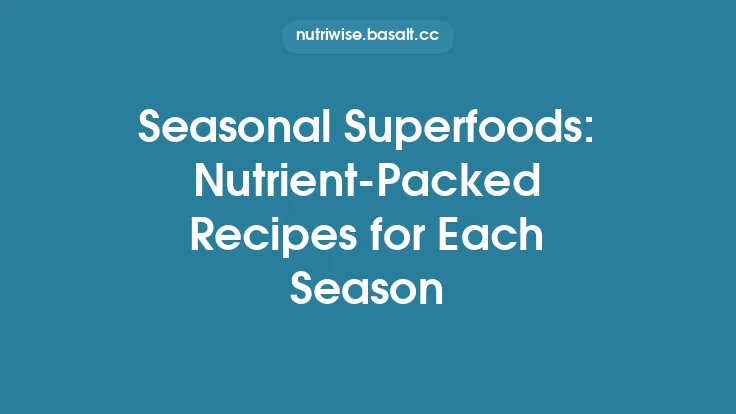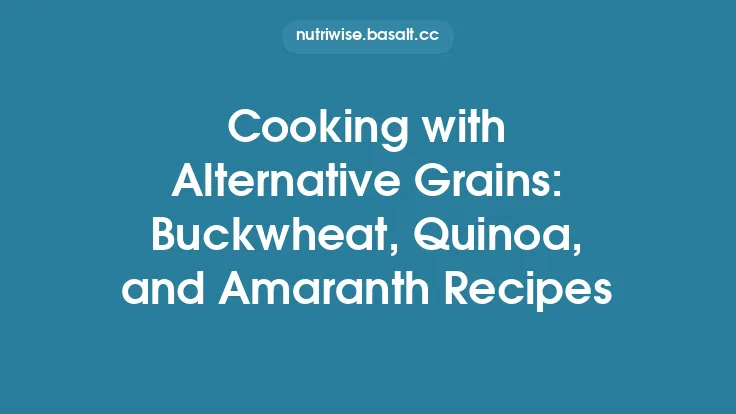Autumn brings a bounty of earthy, sweet, and aromatic ingredients that naturally lend themselves to comforting, nutrient‑dense meals. The cooler weather invites slower cooking methods—roasting, simmering, and braising—that coax deep flavors from pumpkins, squashes, root vegetables, and stone fruits. By understanding the nutritional strengths of these fall staples and applying a few strategic cooking techniques, you can create a collection of recipes that not only satisfy the palate but also support optimal health throughout the season.
The Nutrient Landscape of Fall Produce
| Ingredient | Key Vitamins & Minerals | Phytonutrients & Health Benefits |
|---|---|---|
| Pumpkin & Butternut Squash | Vitamin A (β‑carotene), Vitamin C, potassium, magnesium | Antioxidant carotenoids reduce oxidative stress; fiber supports gut health |
| Sweet Potatoes | Vitamin A, Vitamin C, manganese, copper | Anthocyanins (in purple varieties) provide anti‑inflammatory effects |
| Brussels Sprouts | Vitamin K, Vitamin C, folate, iron | Glucosinolates may support detoxification pathways |
| Apples & Pears | Vitamin C, potassium, copper | Polyphenols (quercetin, catechin) contribute to cardiovascular health |
| Cranberries | Vitamin C, manganese, vitamin K1 | Proanthocyanidins help maintain urinary tract health |
| Pomegranates | Vitamin C, vitamin K, folate | Punicalagins exhibit strong antioxidant activity |
| Maple Syrup | Manganese, zinc, calcium | Contains unique phenolic compounds with anti‑inflammatory properties |
| Nuts & Seeds (walnuts, pumpkin seeds) | Vitamin E, magnesium, selenium, omega‑3 fatty acids | Plant‑based omega‑3s support brain health; phytosterols aid cholesterol management |
Understanding these profiles allows you to design meals that balance macronutrients (protein, complex carbs, healthy fats) while delivering a spectrum of micronutrients essential for immune function, energy metabolism, and cellular repair—particularly important as daylight wanes and the body’s demands shift.
Building Balanced Autumn Meals
- Start with a Base of Complex Carbohydrates
Roasted root vegetables, whole‑grain grains (farro, quinoa, barley), and legumes provide sustained energy and fiber. Their low glycemic index helps stabilize blood sugar, which can be beneficial during the more sedentary winter transition.
- Incorporate Lean Protein or Plant‑Based Alternatives
Seasonal proteins such as turkey, wild‑caught salmon, or plant proteins like lentils and chickpeas complement the carbohydrate base and aid muscle maintenance. Pairing protein with fiber‑rich vegetables improves satiety and nutrient absorption.
- Add Healthy Fats for Flavor and Nutrient Uptake
A drizzle of cold‑pressed olive oil, a handful of toasted pumpkin seeds, or a spoonful of nut butter not only enriches taste but also enhances the bioavailability of fat‑soluble vitamins (A, D, E, K) abundant in autumn produce.
- Season with Aromatic Herbs and Spices
Cinnamon, nutmeg, sage, rosemary, and thyme are more than flavor boosters; they contain bioactive compounds that may modulate blood glucose and inflammation. Use them liberally to create depth without excess sodium.
- Finish with a Touch of Natural Sweetness
A splash of pure maple syrup, a sprinkle of dried cranberries, or a swirl of apple compote can balance savory notes while delivering additional antioxidants.
By following this framework, each recipe in the collection becomes a self‑contained nutritional package, adaptable to a variety of dietary preferences.
Recipe 1 – Roasted Butternut Squash Soup with Sage‑Infused Coconut Cream
Servings: 4 | Prep time: 15 min | Cook time: 35 min
Ingredients
- 1 large butternut squash (≈ 2 lb), peeled, seeded, and cubed
- 2 tbsp olive oil
- 1 medium onion, diced
- 2 garlic cloves, minced
- 1 tsp fresh sage, finely chopped (plus extra leaves for garnish)
- 4 cups low‑sodium vegetable broth
- 1 cup unsweetened coconut milk
- Salt and freshly ground black pepper, to taste
- Optional: 1 tbsp toasted pumpkin seeds for topping
Technique & Nutrition Highlights
- Roasting for Maillard Development – Toss the squash cubes with olive oil, salt, and pepper; roast at 400 °F for 25 minutes until caramelized. The high heat triggers Maillard reactions, deepening flavor and creating a subtle sweetness that reduces the need for added sugars.
- Sautéing Aromatics – In a large pot, gently sauté onion and garlic in a splash of oil until translucent. This step releases sulfur compounds from garlic, which have been linked to cardiovascular benefits.
- Simmer & Blend – Add roasted squash, sage, and broth; simmer 10 minutes. Transfer to a high‑speed blender, incorporate coconut milk, and blend until silky. Coconut milk contributes medium‑chain triglycerides (MCTs) that are readily oxidized for energy.
- Finish & Serve – Adjust seasoning, drizzle a swirl of coconut cream, and garnish with sage leaves and pumpkin seeds for added zinc and magnesium.
Nutrient Snapshot (per serving):
Calories ≈ 210 | Protein ≈ 3 g | Carbs ≈ 28 g | Fat ≈ 10 g (mostly unsaturated) | Fiber ≈ 5 g | Vitamin A ≈ 350 % DV
Recipe 2 – Apple‑Cinnamon Quinoa Breakfast Bowl
Servings: 2 | Prep time: 5 min | Cook time: 20 min
Ingredients
- 1 cup quinoa, rinsed
- 2 cups water or unsweetened almond milk
- 1 large apple, diced (preferably a sweet‑tart variety like Honeycrisp)
- 1 tsp ground cinnamon
- 1 tbsp pure maple syrup
- 2 tbsp chopped walnuts
- 1 tbsp chia seeds
- Pinch of sea salt
Technique & Nutrition Highlights
- Quinoa as a Complete Protein – Cook quinoa in water or almond milk; the latter adds calcium and a subtle nutty flavor. Quinoa supplies all nine essential amino acids, making it an excellent plant‑based protein source.
- Spice Infusion – Add cinnamon and a pinch of salt to the cooking liquid. Cinnamon stabilizes post‑prandial glucose spikes, while salt enhances mineral absorption.
- Apple Caramelization – In a skillet, lightly sauté apple pieces with maple syrup and a dash of cinnamon until they soften and develop a glossy coating. This method reduces the need for additional sweeteners.
- Layer & Top – Assemble the bowl with cooked quinoa, caramelized apples, walnuts, and chia seeds. Chia seeds contribute omega‑3 fatty acids and soluble fiber, promoting satiety and gut health.
Nutrient Snapshot (per serving):
Calories ≈ 350 | Protein ≈ 9 g | Carbs ≈ 55 g | Fat ≈ 12 g | Fiber ≈ 8 g | Calcium ≈ 15 % DV
Recipe 3 – Maple‑Glazed Salmon with Roasted Brussels Sprouts and Sweet Potato Mash
Servings: 4 | Prep time: 10 min | Cook time: 30 min
Ingredients
- 4 salmon fillets (6 oz each), skin on
- 2 tbsp pure maple syrup
- 1 tbsp Dijon mustard
- 1 tbsp apple cider vinegar
- 1 lb Brussels sprouts, trimmed and halved
- 2 tbsp olive oil
- 2 large sweet potatoes, peeled and cubed
- ¼ cup low‑fat Greek yogurt
- 1 tsp fresh rosemary, minced
- Salt, pepper, and smoked paprika to taste
Technique & Nutrition Highlights
- Glaze Chemistry – Combine maple syrup, mustard, and vinegar. The acidity from vinegar balances the sweetness, while mustard adds a source of selenium and omega‑3s from the seeds.
- High‑Heat Roasting – Toss Brussels sprouts with olive oil, rosemary, and smoked paprika; roast at 425 °F for 20 minutes. The charred edges increase the concentration of flavor compounds like phenols, reducing the need for excess salt.
- Salmon Searing – Place salmon skin‑side down on a hot skillet, sear 3 minutes, then brush with glaze and finish in the oven for 6‑8 minutes. The searing creates a crisp skin that locks in moisture and omega‑3 fatty acids (EPA/DHA), essential for brain health.
- Sweet Potato Mash – Boil sweet potatoes until tender, then mash with Greek yogurt, a pinch of salt, and a drizzle of maple syrup for subtle sweetness. Greek yogurt adds probiotic cultures and calcium.
- Plate Composition – Serve salmon atop a bed of Brussels sprouts with a side of sweet potato mash. The plate offers a balanced macronutrient profile: protein from salmon, complex carbs from sweet potatoes, and fiber‑rich vegetables.
Nutrient Snapshot (per serving):
Calories ≈ 420 | Protein ≈ 32 g | Carbs ≈ 35 g | Fat ≈ 18 g (rich in omega‑3) | Fiber ≈ 6 g | Vitamin C ≈ 120 % DV
Recipe 4 – Pumpkin Lentil Chili with Cranberry‑Infused Yogurt Drizzle
Servings: 6 | Prep time: 15 min | Cook time: 45 min
Ingredients
- 1 cup dried red lentils, rinsed
- 1 cup canned pure pumpkin puree (no added sugar)
- 1 large onion, diced
- 2 garlic cloves, minced
- 1 red bell pepper, diced
- 1 carrot, grated
- 2 tbsp olive oil
- 2 tsp ground cumin
- 1 tsp smoked paprika
- ½ tsp ground coriander
- 1 tsp chili powder (adjust to taste)
- 4 cups low‑sodium vegetable broth
- 1 tbsp tomato paste
- ¼ cup dried cranberries, finely chopped
- ½ cup plain low‑fat Greek yogurt
- Fresh cilantro, lime wedges for garnish
- Salt and pepper to taste
Technique & Nutrition Highlights
- Lentils as a Fiber Powerhouse – Red lentils cook quickly and provide soluble fiber, which can help lower LDL cholesterol. Their high lysine content complements the methionine‑rich pumpkin, creating a more complete amino acid profile.
- Spice Layering – Toast cumin, coriander, and smoked paprika in oil before adding aromatics. This releases essential oils, enhancing both flavor and antioxidant capacity.
- Pumpkin Integration – Adding pumpkin puree not only imparts a velvety texture but also boosts beta‑carotene levels, supporting eye health.
- Cranberry‑Yogurt Drizzle – Mix chopped cranberries into Greek yogurt with a pinch of salt. The tartness of cranberries cuts through the richness of the chili, while the yogurt adds probiotics and a creamy mouthfeel.
- Simmer & Meld – Allow the chili to simmer gently for 30 minutes, enabling lentils to absorb the broth and spices fully. This slow cooking maximizes nutrient extraction from the vegetables.
Nutrient Snapshot (per serving):
Calories ≈ 280 | Protein ≈ 14 g | Carbs ≈ 38 g | Fat ≈ 8 g | Fiber ≈ 10 g | Iron ≈ 20 % DV
Recipe 5 – Spiced Pear Crisp with Oat‑Almond Topping
Servings: 8 | Prep time: 10 min | Cook time: 35 min
Ingredients
- 6 ripe pears, peeled, cored, and sliced
- 2 tbsp melted coconut oil
- 2 tbsp pure maple syrup
- 1 tsp ground ginger
- ½ tsp ground cinnamon
- ¼ tsp ground cloves
- Topping:
- 1 ½ cups rolled oats (gluten‑free if needed)
- ½ cup almond flour
- ¼ cup chopped toasted almonds
- 2 tbsp brown sugar (optional)
- 2 tbsp melted butter or coconut oil
- Pinch of sea salt
Technique & Nutrition Highlights
- Fruit Caramelization – Toss pear slices with coconut oil, maple syrup, and spices; bake at 375 °F for 15 minutes before adding the topping. This gentle caramelization intensifies natural sugars without the need for refined sweeteners.
- Whole‑Grain Topping – Oats provide beta‑glucan soluble fiber, which can aid in blood glucose regulation. Almond flour and toasted almonds contribute healthy monounsaturated fats, vitamin E, and magnesium.
- Balancing Sweetness – The modest amount of brown sugar (optional) can be omitted for a lower‑glycemic version, relying on the inherent sweetness of pears and maple syrup.
- Baking Dynamics – The topping crisps up in the final 20 minutes, creating a contrast of textures that enhances satiety and enjoyment.
Nutrient Snapshot (per serving):
Calories ≈ 210 | Protein ≈ 3 g | Carbs ≈ 35 g | Fat ≈ 8 g | Fiber ≈ 5 g | Calcium ≈ 6 % DV
Meal Planning Strategies for the Autumn Season
- Batch‑Cook Core Components
- Roasted Vegetables: Prepare a large tray of mixed root vegetables (carrots, parsnips, beets) seasoned with rosemary and olive oil. Store in airtight containers for up to 5 days; they can be reheated or added cold to salads.
- Grains & Legumes: Cook a big pot of quinoa, farro, or lentils at the start of the week. Portion into individual servings for quick assembly of bowls or soups.
- Create a Seasonal Pantry Stock
- Shelf‑Stable Essentials: Canned pumpkin, pure maple syrup, dried cranberries, and high‑quality olive oil.
- Spice Arsenal: Ground cinnamon, nutmeg, allspice, smoked paprika, and dried sage. These spices not only flavor dishes but also contribute antioxidant compounds.
- Plan for Leftover Reinvention
- Soup to Sauce: Blend leftover roasted squash into a creamy sauce for whole‑grain pasta.
- Breakfast Remix: Turn extra quinoa into a cold breakfast parfait with yogurt, apple slices, and a sprinkle of toasted pumpkin seeds.
- Mindful Portioning for Energy Balance
Autumn days often see a dip in physical activity. Use visual portion guides—half the plate with non‑starchy vegetables, a quarter with lean protein, and a quarter with complex carbs—to maintain energy equilibrium without feeling deprived.
- Incorporate Seasonal Snacks
- Nut‑Seed Mix: Combine roasted pumpkin seeds, walnuts, and a pinch of sea salt for a portable, nutrient‑dense snack.
- Fruit‑Spice Pairings: Slice an apple, drizzle with a dash of cinnamon, and pair with a spoonful of almond butter for a balanced mini‑meal.
Food Safety and Storage Tips for Autumn Ingredients
- Root Vegetables (Potatoes, Carrots, Beets): Store in a cool, dark, well‑ventilated area (45‑55 °F). Avoid refrigeration, which can convert starches to sugars, altering flavor and texture. Check weekly for soft spots and remove any compromised pieces to prevent spread of rot.
- Squash & Pumpkins: Keep whole in a dry, temperature‑controlled environment (50‑60 °F). Once cut, wrap tightly in plastic wrap and refrigerate; use within 3‑5 days. For longer storage, freeze cubed squash after blanching for 2 minutes.
- Apples & Pears: Store in the refrigerator’s crisper drawer, ideally in a perforated bag to maintain humidity. Separate ethylene‑producing fruits (apples) from ethylene‑sensitive vegetables (leafy greens) to extend shelf life.
- Brussels Sprouts: Keep unwashed in a perforated bag in the fridge’s lower drawer. They stay fresh for up to 10 days; discard any yellowed outer leaves before cooking.
- Nuts & Seeds: Transfer to airtight containers and store in the freezer to prevent rancidity, especially for high‑oil varieties like walnuts and pumpkin seeds.
Adapting Recipes for Common Dietary Preferences
| Preference | Substitutions & Adjustments |
|---|---|
| Vegetarian / Vegan | Replace salmon with marinated tofu or tempeh; use coconut yogurt instead of Greek yogurt; swap butter for plant‑based margarine in the crisp topping. |
| Gluten‑Free | Ensure oats are certified gluten‑free; use quinoa or millet as grain bases; replace wheat‑based breadcrumbs with almond flour in any coating. |
| Low‑Sodium | Reduce added salt; use low‑sodium broth; enhance flavor with herbs, citrus zest, and umami‑rich ingredients like nutritional yeast. |
| Diabetic‑Friendly | Limit maple syrup to 1 tsp per serving; increase fiber by adding chia seeds or psyllium husk; pair carbohydrate‑rich dishes with protein and healthy fats to blunt glucose spikes. |
| Paleo | Omit dairy yogurt; use coconut cream or avocado for creaminess; replace quinoa with cauliflower rice; sweeten with extra fruit or a drizzle of raw honey (if tolerated). |
These modifications preserve the core flavor profile while aligning the dishes with individual nutritional goals.
The Science of Autumn Flavor Pairings (A Practical Overview)
While a deep dive into the biochemical mechanisms of flavor synergy belongs to a separate, more technical treatise, a practical understanding can guide recipe creation:
- Sweet + Earthy: Pairing maple syrup or apples with pumpkin, sweet potatoes, or roasted carrots balances natural sugars with grounding, umami‑rich notes.
- Savory + Tart: A splash of apple cider vinegar or a dollop of cranberry‑yogurt introduces acidity that cuts through rich, fatty components like salmon or cheese.
- Spice + Fat: Cinnamon, nutmeg, and clove meld beautifully with the buttery mouthfeel of roasted nuts or coconut milk, creating a harmonious mouthfeel.
- Herb + Citrus: Fresh sage or rosemary combined with a squeeze of lemon or orange zest brightens heavy stews and braises, enhancing nutrient absorption (e.g., vitamin C improves iron uptake from lentils).
Applying these pairings intuitively can elevate dishes without the need for extensive ingredient lists.
Closing Thoughts
Autumn’s bounty offers a remarkable palette of flavors, textures, and nutrients that, when approached thoughtfully, can transform everyday meals into comforting, health‑promoting experiences. By grounding recipe development in the nutritional strengths of seasonal produce, employing cooking techniques that amplify flavor while preserving micronutrients, and integrating practical meal‑planning strategies, you can enjoy a month-long culinary journey that supports both body and soul.
Embrace the warmth of roasted squash, the crisp sweetness of apples, and the aromatic depth of sage and cinnamon. Let these ingredients guide you toward balanced plates, mindful eating, and a deeper appreciation for the seasonal rhythm that nature provides. Happy cooking, and may your autumn be as nourishing as it is delicious!





